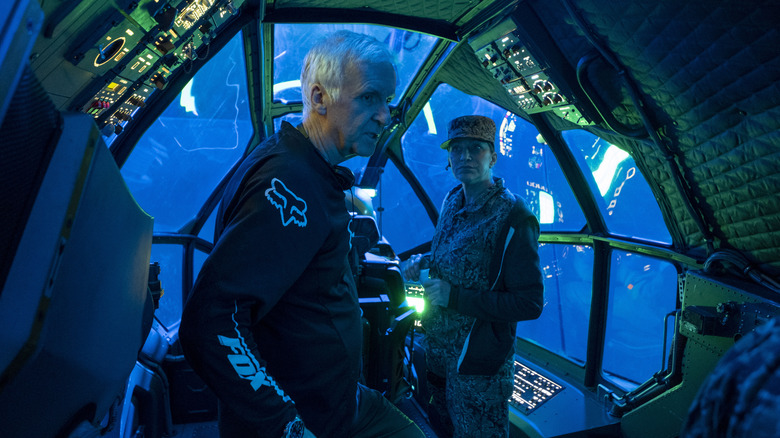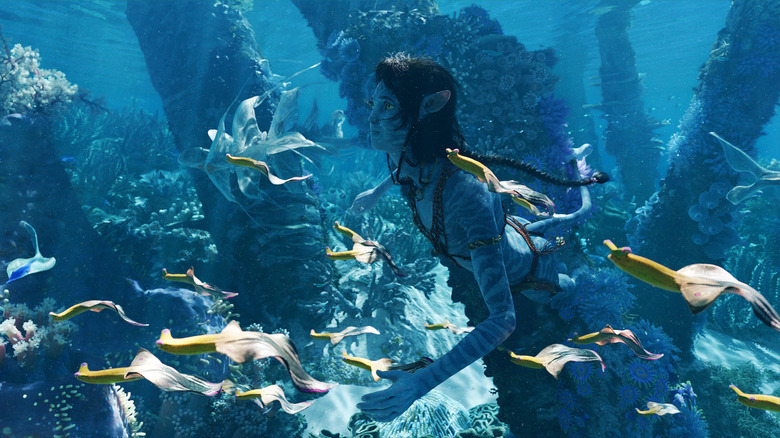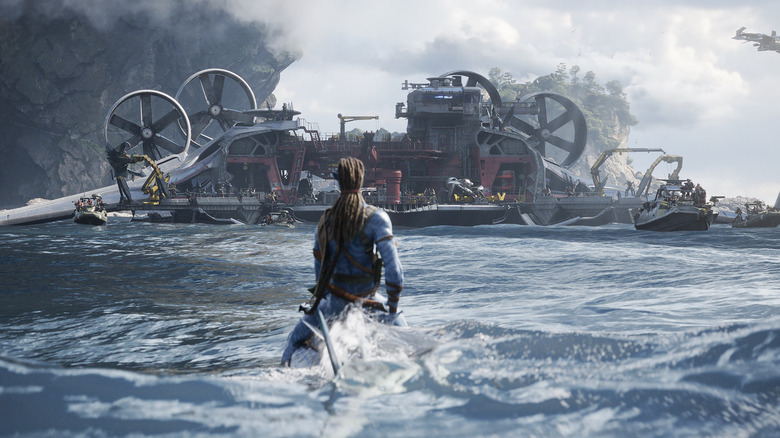To Fully Understand James Cameron's Genius, You Have To Watch This Documentary
There's an element of problem solving to all film productions, but there isn't a filmmaker alive who loves making the problems as big as possible more than James Cameron. After proving himself as a top-tier action director with "The Terminator" and "Aliens," Cameron took his cast and crew literally underwater for the sci-fi marvel "The Abyss." Though that film was a box office disappointment, Cameron plunged forward with the technically audacious "Terminator 2: Judgement Day," which, at the time, was the most expensive movie ever made. After this, he challenged himself with the wildly expensive, technically complex spy action-comedy "True Lies." Feeling invincible, he followed that success with "Titanic," which everyone in Hollywood believed would be a disaster until it became the top grossing movie of all time, earning Cameron Oscars for Best Picture and Best Director.
The filmmaker spent the better part of the next decade scratching his underwater exploration itch, returning topside with the documentaries "Ghosts of the Abyss" and "Aliens of the Deep." These were essentially palate cleansers for the wildly ambitious problem-solving project that is the "Avatar" franchise.
For there to even be a franchise, Cameron had to first deliver a blockbuster that would recoup its massive $237 million budget (and then some). Once again, Hollywood thought Cameron had gone too far, but here we are in 2025 awaiting the third movie in the property, "Avatar: Fire and Ash." That the film is coming out three years after "Avatar: The Way of Water" is something of a surprise, considering it took Cameron 13 years to complete the previous installment.
The Disney+ documentary "Fire and Water: Making the Avatar Movies" depicts how Cameron solved the biggest filmmaking problem of his career in mind-blowing detail. In doing so, it also solves the mystery of the man's singular brilliance.
Taking Avatar underwater was a trial by fire
The title "Fire and Water: Making the Avatar Movies" is a tad misleading because the documentary is almost solely focused on the production of "The Way of Water." In two episodes running a combined 83 minutes, we bear witness to the full range of Cameron's dazzling skills. He's not just a tremendously talented director, he's also an engineer whose perfectionism drives him to invent his way around the problems he repeatedly, almost gleefully, creates for himself. In the first episode, he admits that he "opened up a giant can of whup-ass" on the production by insisting on filming portions of the hybrid motion-capture movie underwater. Boy, did he ever.
Cameron's first instinct was to simulate the underwater scenes via elaborate wire work. The footage of these tests left me feeling like they'd captured the feeling of swimming, but Cameron swings in and nixes it because they can't fully capture the resistance human beings experience while propelling themselves against water. A part of me thinks this approach was thrust upon Cameron as a cost-saving measure, hoping that he wouldn't bring the shoot underwater, as has been his wont throughout his career. No such luck. And here's where we discover why the sequel was 13 years in the making.
If I have an issue with the documentary, it's that it doesn't timestamp the behind-the-scenes footage. I'd love to know how long it took for Cameron et al. to go from testing ultraviolet digital cameras in producer Jon Landau's backyard pool to constructing a one-of-a-kind Manhattan Beach Studios tank outfitted with a 20-ton wave machine. Still, it's impressive to watch Cameron and his fiercely committed crew clear this obstacle. In a way, this is Cameron's opportunity to prove he hadn't gone off-the-rails making "The Abyss."
The Avatar movies have mellowed James Cameron
Once the engineering problems are solved, it's time for Cameron to figure out how to get his actors comfortable with free diving techniques. Sigourney Weaver, Kate Winslet, and Zoe Saldaña admit to being highly skeptical of being able to physically perform as Cameron asked, but rather than hurl his actors feet-first into a potentially dangerous situation as he did with the "Abyss" cast, he hires a free-diving practitioner to train them in the art of holding your breath for a very long time. This marks maturity in Cameron's process, and the cast responds by pushing themselves to accomplish what was once unthinkable.
When the production moves to an Auckland, New Zealand studio outfitted with a tank that meets Cameron's specifications, we watch the crew build actual, functioning ships. At this point, the mission of the documentary becomes clear: Cameron can talk until he's blue in the face about the practicality of shooting an "Avatar" movie, but the layman moviegoer needs to see with their own two eyes how he did it.
"Fire and Water: Making the Avatar Movies" is a fascinating portrait of how a filmmaker once feared/reviled for his dictatorial style eased up on the reins and gave his cast and crew a sense of ownership in the process. It's a family atmosphere that allows each participant the potential of epiphanies (Cliff Curtis' encounter with very real manta rays is particularly moving) without sacrificing the muscular, bruising aesthetic that defines Cameron's cinema. It also makes a case that the actors should be considered for Oscars because they're going above and beyond. If you love watching people achieve the impossible, you can't do better than spending 83 minutes witnessing Cameron's genius.
"Avatar: Fire and Ash" opens in theaters on December 19, 2025.


